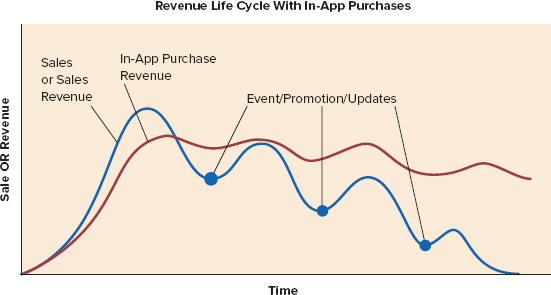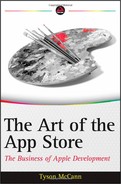POTENTIAL RISK AND REWARD
As you'll see in Chapter 8, one of the several reasons to create an app that's a bit more expensive (such as at $1.99 and above) is that you can count on successive price-reduction updates or promotions to lift a potentially sagging sales curve. If you start with your app at 99 cents, for example, there's nowhere to go but free.
Well, there used to be nowhere to go. Back before in-app purchases became available, creating a free app had some definite points against it — among them, how to properly upsell your associated premium app, or how best to utilize in-app advertising. Now that all apps can use this functionality, it's becoming a dominating factor in app design. Free apps not only are downloaded more often, but now have the potential to earn big revenue through in-app purchases in addition to the tried and sometimes true ad payouts.
In summary, creating a free app presents much less risk if you're planning on using in-app purchases, or have another version you want people to buy, because it will likely get viewed more often. Why, then, would you want a low priced, 99-cent app? Should you charge more? Let's take a look at the considerations you'll need to work out before deciding on a price point, whether 99 cents or more.
Paid Apps Are Seen as WYSIWYG
There's an expectation from customers that if they pay for an app, little to no additional payment will be requested post purchase. What you see is what you get (WYSIWYG). The value should be built into the app price, and the higher that price, the stronger the mentality. Though customers are beginning to find in-app purchases as more of a standard offering, and are less inclined to complain, the basic assumption going into a paid app is still that it should present more overall value than a free app.
What Incentives Can You Provide When Sales Dwindle?
Updates beyond bug fixing (though also important) are a great way to keep your app visible. Will your app be able to provide feature or content updates post release? If not, you may want to consider alternatives to 99-cent pricing to keep potential incentives in place, unless you're sure of a maintainable position in your niche (whether game or app). Having said that, because games are not selling features per se, but rather entertainment, it is important to make the distinction that when an app is based on a feature set (say, Twitter), it is more likely to become outdone or outdated, and at a quicker pace.
Are You Planning on In-App Purchases?
Do your plans include in-app purchases for downloadable content such as new levels, modes, items, or functionality (for example, the removal of ads for a price)? If so, be sure there's a lot of value present at 99 cents before asking users to pay for more. The balance of value vs. paid in-app purchases in paid apps will be discussed in Chapter 8.
Can You Go Free?
With significantly more downloads for free apps than paid apps, if you're considering the 99-cents price point, it's worth considering whether you can support going free.
For free apps, and before in-app purchases, creating a “lite” restricted version for users to try with an upsell to the paid version (that unlocks certain functionality) is an early and still highly-recommended strategy. The newer alternative is making it free and fully functional, and then using in-app purchases, add the option to buy (“unlock”) new content or features (such as levels or modes).
Like Winning the Lottery
You never really know whether your app is going to take off. After all, many great apps (for one reason or another) simply don't. If you have one that's not as popular as it could be, usually it can be attributed to one or more items from the following list, sometimes in combination:
- You have insufficient marketing. Did you target the right channels? For example, did you spend on print over online, or pay for a single banner ad for a popular related site, and so on?
- You have ill-timed marketing. This could cover everything from your release date to when you launch targeted campaigns.
- Your app keywords are not appropriately bringing traffic.
- Your submitted category is not the best-suited to your app.
- Your niche is already saturated with other more popular and/or similarly featured apps.
The eventual goal is to make it into the Top 100, which is considered by many to be the point at which your app can self-sustain its sales primarily because of visibility and the number of downloads (even though number of downloads per app are top-heavy even within the top 100).
Another in-iTunes occurrence is the possibility of making it onto the incredibly small list of “App of the Week” titles. If you manage either of these distinctions, it can feel like winning the lottery.
![]() With “Archetype,” the developers did not submit for “App of the Week,” nor did they know it was selected. The exact process Apple has for selection is unfortunately secret, so there is no definitive formula.
With “Archetype,” the developers did not submit for “App of the Week,” nor did they know it was selected. The exact process Apple has for selection is unfortunately secret, so there is no definitive formula.
Following are some general (though important) guidelines for not only having a hit, but making it into the “App of the Week” (which gets your app prominently featured at the top of the App Store in a large rotating banner):
- Create a good app — Yes, this is completely obvious. However, if you are in the market mostly to capitalize on a niche that hasn't been saturated yet, without exactly the care or polish that Apple takes seriously, you may make it into the Top 100, but will have no chance of making “App of the Week.” Carve out a definitive niche, keep it bug free, and respond to feedback.
- Get good press — If most of your reviews are positive, those at Apple who are often gamers and do take u002 of popular i-device blogs and review sites will notice. They'll see the buzz, and your app may have a better chance. It's what the developers of “Archetype” did, and it did work for them.
- Be an underdog — Sometimes the big companies with hyped releases get snubbed for the “App of the Week.” More often, apps from new developers will appear out of nowhere to be prominently featured. This is good news for most of us. After all, if the Average Joe and indie developers of the world can't dream of hitting it big in the App Store, then it wouldn't be nearly as popular as it has been. It's the same psychological process that goes on with the lottery.
- Carve out a niche of your own — Be different from your competitors in tangible ways. This goes back to competitive research, but ensure that your app has unique selling points that make it indispensible in terms of fun and/or value. Clones of other games usually need not apply here.
So, creating a hit app can sometimes feel like winning a lottery, but unlike the lottery, revenue can be unpredictable.
Revenue Like a Rollercoaster
Whether or not your app hits it big, the App Store market will continue to fluctuate. Just as in any business, you'll see periods of growth and decline (hopefully much more of the former). As you keep an eye on sales and competitors, you'll have to adapt accordingly to changing conditions, perhaps with price decreases to offset a competitor's launch. If you were to graph the expected revenue of your average paid app (not including ad revenue), it would look something like a rollercoaster, as shown in Figure 6-1.

FIGURE 6-1: When revenue is tied to sales only, it can look like a rollercoaster over the app's life cycle
These days, however, with in-app purchases, there is the potential to even out the ride, and continue to earn revenue because it no longer depends only on app sales. Once you can get a steady stream of users and utilize in-app purchases with regular updates, you'll be earning revenue even in periods of slow app sales/downloads.
Figure 6-2 shows the sales curve from before, along with the new in-app purchase revenue curve. This type of in-app purchase curve might best apply to a free app with in-app purchases and regular updates. As you can see, even when sales or downloads dwindle, you can still earn revenue through updates that might include more in-app purchases.

FIGURE 6-2: With in-app purchases, you have a chance at more steady revenue, even after sales decline
